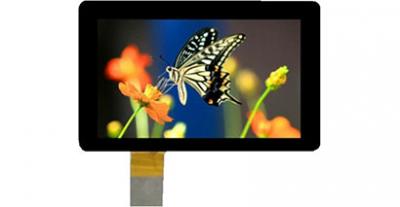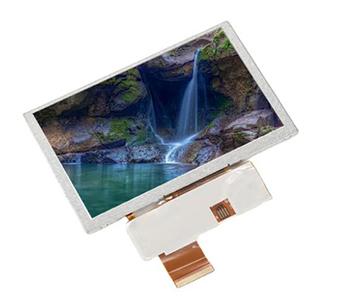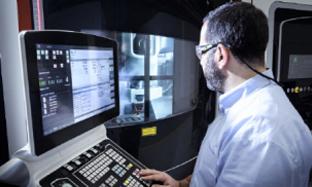When designing the LCD liquid crystal display enclosure, we should follow some basic principles, with the most important parameters being the size of the LCD screen and the display area. Below, we will introduce the enclosure design for assembling LCD liquid crystal screens from three aspects: important parameters of the LCD screen, enclosure size design, and enclosure assembly process.
Outer dimensions (TFT OD): The external dimensions of the LCD display;
Visible area (TFT OPEN): The visible area of the LCD display, the area that can be seen;
Effective area (TFT AA): The active area of the LCD display, where the pixels are located.
If the window of the LCD liquid crystal display enclosure is larger than the visible area (TFT OPEN), the metal frame of the display screen will be exposed, which will be very unsightly. On the other hand, if the window is smaller than the effective area (TFT AA), we will cover up the image displayed on the screen.
Therefore, we should start designing the LCD liquid crystal screen enclosure from the most important parameter sizes, which are OD, OPEN, and AA.
It is worth noting that the opening in the enclosure for the display screen should be larger than the external dimensions (OD) of the LCD liquid crystal display included in the drawings, as the display screen cannot be tightly placed on the enclosure, which would cause damage to the FFC tape or display screen. An offset of approximately 2mm may be suitable.
When designing the enclosure for a touchscreen module, you should pay attention to the dimensions (length, width, and radius of the corners) of the upper glass, the touch panel, the thickness of the glass, and the mounting tape. Additionally, a very important factor is positioning the display screen relative to the touch panel.
The correct assembly process of the LCD display module in the enclosure is crucial. Common damages that occur during incorrect assembly processes include damage to the FFC, separation of the TP and TFT, damage to the TFT glass, and bending of the LCD frame.
In the first stage of installing the display module in the enclosure, you should pay attention to protecting the edges of the FFC to ensure it is not damaged.
We recommend using support brackets assembled on the back of the display screen, as additional support will make the entire structure more rigid and minimize the impact of external factors such as vibration and temperature changes.
Be particularly careful when installing the LCD liquid crystal display into the enclosure, and do not apply excessive pressure to the module, as excessive pressure will not help to achieve better adhesion.
 Enhancing the Gaming Experience with TFT Display Touch ScreensDecember 8, 2023In the ever-evolving landscape of gaming technology, one innovation stands out as a game-changer—TFT display touch screens. These sleek and responsive screens have taken the gaming experience to new ...view
Enhancing the Gaming Experience with TFT Display Touch ScreensDecember 8, 2023In the ever-evolving landscape of gaming technology, one innovation stands out as a game-changer—TFT display touch screens. These sleek and responsive screens have taken the gaming experience to new ...view How the TFT display worksDecember 9, 20221. How does TFT display work?How does TFT display work? TFT is the abbreviation of Thin Film Transistor, which generally refers to thin film liquid crystal display, but actually refers to ...view
How the TFT display worksDecember 9, 20221. How does TFT display work?How does TFT display work? TFT is the abbreviation of Thin Film Transistor, which generally refers to thin film liquid crystal display, but actually refers to ...view TE Signal of TFT Display ModuleMarch 31, 2023The background of TFT display moduleTFT displays with MCU interface generally have an interface with the "TE" signal. The TE signal is an output interface that can provide normal display eve...view
TE Signal of TFT Display ModuleMarch 31, 2023The background of TFT display moduleTFT displays with MCU interface generally have an interface with the "TE" signal. The TE signal is an output interface that can provide normal display eve...view Navigating the Future: The Wonders of LCD Touch ScreensNovember 17, 2023In the ever-expanding landscape of interactive technology, LCD touch screens have become the unsung heroes, transforming the way we engage with our digital devices. From smartphones and tablets to int...view
Navigating the Future: The Wonders of LCD Touch ScreensNovember 17, 2023In the ever-expanding landscape of interactive technology, LCD touch screens have become the unsung heroes, transforming the way we engage with our digital devices. From smartphones and tablets to int...view Do You Know What Types of LCD Displays Are There?September 26, 2022As the mainstream technology in the display industry, LCD display has several types, each with different characteristics.Ⅰ. TN LCD module panel: The biggest feature of TN is that the price is relativ...view
Do You Know What Types of LCD Displays Are There?September 26, 2022As the mainstream technology in the display industry, LCD display has several types, each with different characteristics.Ⅰ. TN LCD module panel: The biggest feature of TN is that the price is relativ...view How Much Do You Know About Medical LCD Displays?February 8, 2023With the wide application of medical LCD displays in medical instruments and equipment, it is valuable and meaningful for medical equipment engineers to understand and master the common faults and mai...view
How Much Do You Know About Medical LCD Displays?February 8, 2023With the wide application of medical LCD displays in medical instruments and equipment, it is valuable and meaningful for medical equipment engineers to understand and master the common faults and mai...view Call us on:
Call us on:  Email Us:
Email Us:  2F-M1 XiaWei Industrial Park, GuanLan, LongHua District, SZ, China
2F-M1 XiaWei Industrial Park, GuanLan, LongHua District, SZ, China